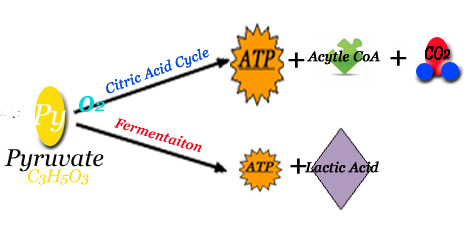Once glucose has made its way into the cells by through the GLUT4 transporters, it enters a chemical cycle to produce adenosine triphospate (ATP). ATP is the stored energy of a cell. Utilization of glucose for energy can happen aerobically as in cells with mitochondria or anaerobically as in red blood cells (no mitochondria).
The first 8 basic steps of glucose metabolism happen in the cytoplasm. Glycolysis is an anaerobic process in which the glucose molecule is converted into pyruvate and 2 net molecules of ATP are formed.
 In the presence of oxygen, the pyruvate will enter the citric acid cycle (Krebs Cycle) where Acytle CoA and CO2 are produced as byproducts, and2* more ATP molecules. 34* more ATP molecules are produces from the electron transport system. (*the amount of total ATP produced is theoretical ideals, lower levels of ATP are actually produced due to other circumstances in the cell)
In the presence of oxygen, the pyruvate will enter the citric acid cycle (Krebs Cycle) where Acytle CoA and CO2 are produced as byproducts, and2* more ATP molecules. 34* more ATP molecules are produces from the electron transport system. (*the amount of total ATP produced is theoretical ideals, lower levels of ATP are actually produced due to other circumstances in the cell)
Muscle cells can convert glucose to energy aerobically however, in when in a low oxygen environment, the cells can also make the conversion without oxygen. This anaerobic conversion releases the metabolic byproduct, lactic acid (which, though contrary to popular belief, is not he reason for post workout muscle soreness).
If oxygen is not present, the pyruvate produced in glycolysis will instead remain in the cytoplasm and undergo fermentation. In this process, waste products are produced and then removed from the cell. As stated above, lactic acid is the waste product of anaerobic respiration of pyruvate. Fermentation also produces ATP, however it is far less efficient as aerobic respiration, producing only 2 ATP per glucose.

March 13, 2009 at 5:06 pm
[…] (J) Glucose Utilized for Energy […]